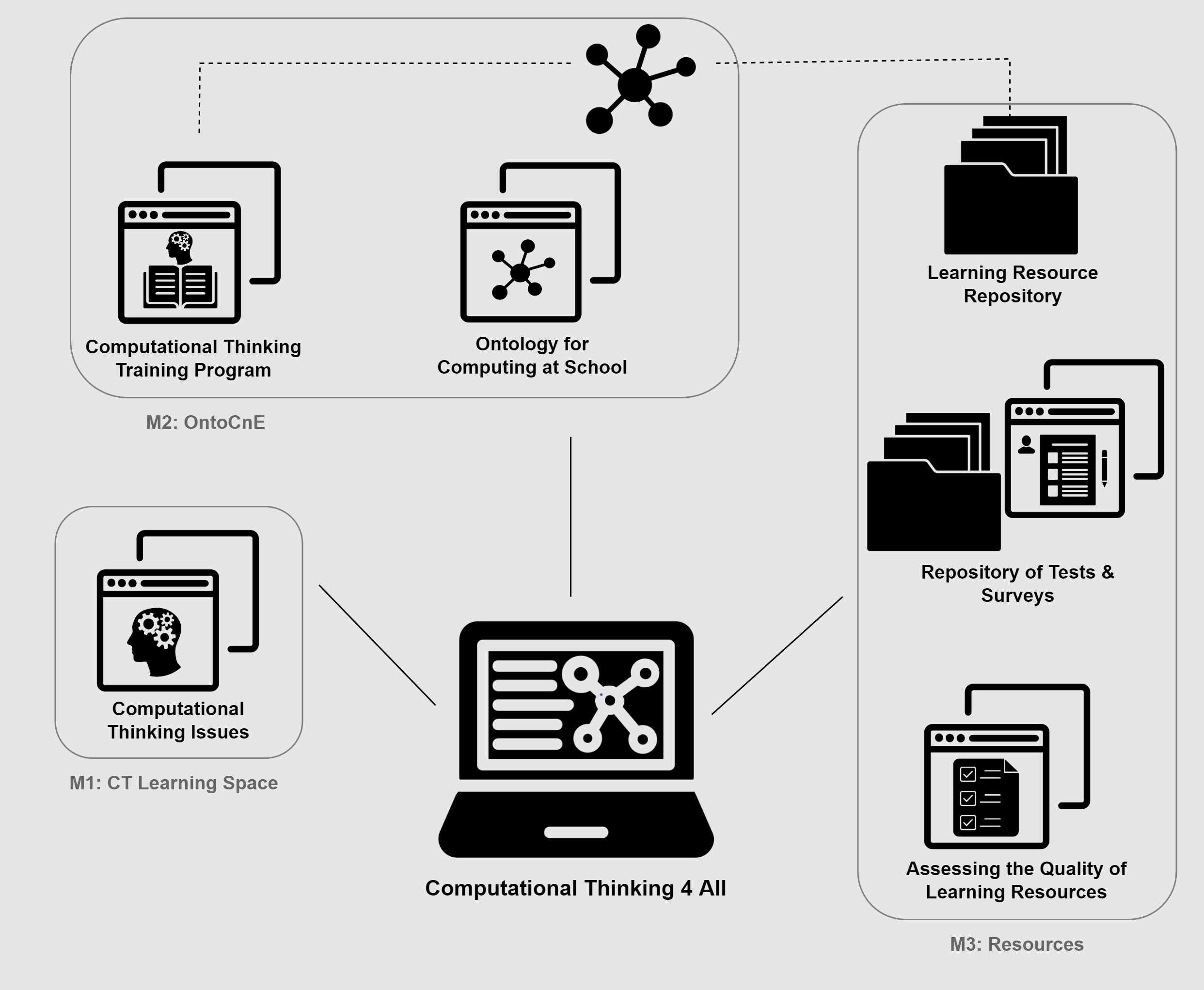About this Project
Computational Thinking 4 All is a platform that aims to promote teaching for the future. This project is not intended to teach facts or formulas, but to train the brain to think, to solve problems, and to reason logically. Its aim is to combine Computational Thinking with Neuroscience in order to find strategies to train the mind to think.
This project came about because students present deficits in problem solving skills, reduced abstraction and logical reasoning skills, and difficulty in interpreting and perceiving problems. These difficulties mean that, when students begin at Computer Programming courses, they have difficulties in following the syllabus and many end up failing or abandoning of the course.

Importantly, this is a general problem for sciences or engineering courses and even in the world of professional education or specialization. In the last years, educators started adopting new teaching approaches and using tools that forster learning, but the improvements have not been very noticeable.
But why can Computational Thinking and Neurosciences help to solve the problem? Computational Thinking is a method for solving problems. Several studies claim that Computational Thinking can help mitigate this problem, if acquired and trained from an early age. For training to be more effective, it is necessary to understand how the brain learns and the best way to promote learning. It is important to understand how factors such as memory, attention, emotions have an impact on the knowledge acquisition process.
Computational Thinking 4 All is the workbench of any teacher who wants to prepare his students to acquire Computational Thinking skills. The Computational Thinking 4 All platform is composed of 3 modules: CT Learning Space, OntoCnE and, Resources. The following figure shows the platform architecture.

Module 1: CT Learning Space
Computational Thinking Issues - in this component the different concepts, approaches, techniques and instruments that describe and characterize Computational Thinking and related matters are present. Some forums, and events on Computational Thinking and initiatives to train it is also be announced and pointed out. This module can be seen as a kind of encyclopedia on Computational Thinking topics, providing definitions and news on the subject and related links where to look for information to learn more about Computational Thinking.
Module 2: OntoCnE
Ontology for Computing at School - in this component, the OntoCnE is present, its purpose and its layered structure. OntoCnE, aims at providing a detailed and rigorous description of two knowledge domains and their interception: Computational Thinking, and Computer Programming. So, OntoCnE is intended to support the design of education programs syllabus on computational thinking as the basis for computer programming. This justifies the importance of making OntoCnE available to the teaching community using a friendly interface.
This ontology is structured in three layers: what concepts are needed to train Computational Thinking (layer 1); what to train at each level of education and how deep to go (layer 2); and what material to use to train Computational Thinking at the various levels of education (layer 3). This component will also include the OntoCnE knowledge repository and conceptual navigation. Conceptual navigation allows the visitor to consult the ontology concepts following logical or semantic paths, according to the relationships that connect them. Since an ontology is a network of related concepts, is possible to move from concept to concept and to understand the hierarchy or relationship that exists among them. In this way it is possible to build easily (during the navigation) knowledge about the domain of Computational Thinking.
Computational Thinking Training Program - this component contain Computational Thinking training programs. For this, it will be necessary to create teaching objectives to train Computational Thinking by age or educational level. It is intended to design along this project a curriculum for the training of Computational Thinking. This curriculum, that will contain training programs for different levels of education and with different levels of complexity, will the accessible through this platform component.
Module 3: Resources
Learning Resource Repository - this component contain created or reused Learning Resources. Learning Resources aim to train Computational Thinking. These resources will satisfy, not only requirements derived from the Computational Thinking skills to be exercised, but also knowledge acquisition and memorization requirements springing out from the studies in Neuroscience. Each Learning Resource besides its description and usage rules will have a guide on how to apply it so that the training is effective. That guide is similar to a medical prescription for a medication.
Repository of Tests & Surveys - this component contain a set of created or reused Efficacy Tests that aim to measure the effectiveness of Computational Thinking training. Learning Resources component, the Efficacy Tests proposed in this component also shall be developed taking into account the approaches suggested by the Neuroscience studies. This component also contain surveys or questionnaires to collect information that allows for measuring whether the training with the proposed Learning Resources has a positive impact on the way students acquire the ability to think computationally. The projected Repository can also include suggestions for surveys targeted to explore the correlation between students' background or socioeconomic roots and their difficulties in programming courses.
Guide to Assessing the Quality of Learning Resources - this component contain a guide with a set of requirements to assess the quality of Learning Resources, mainly in the approaches suggested by Neuroscience.